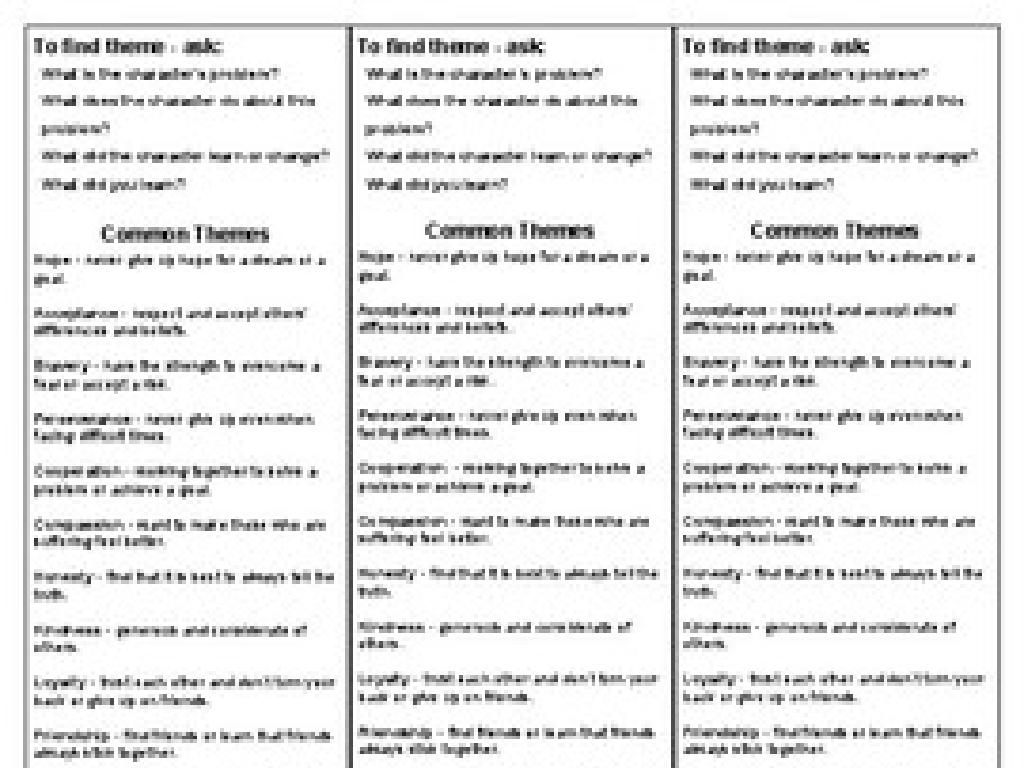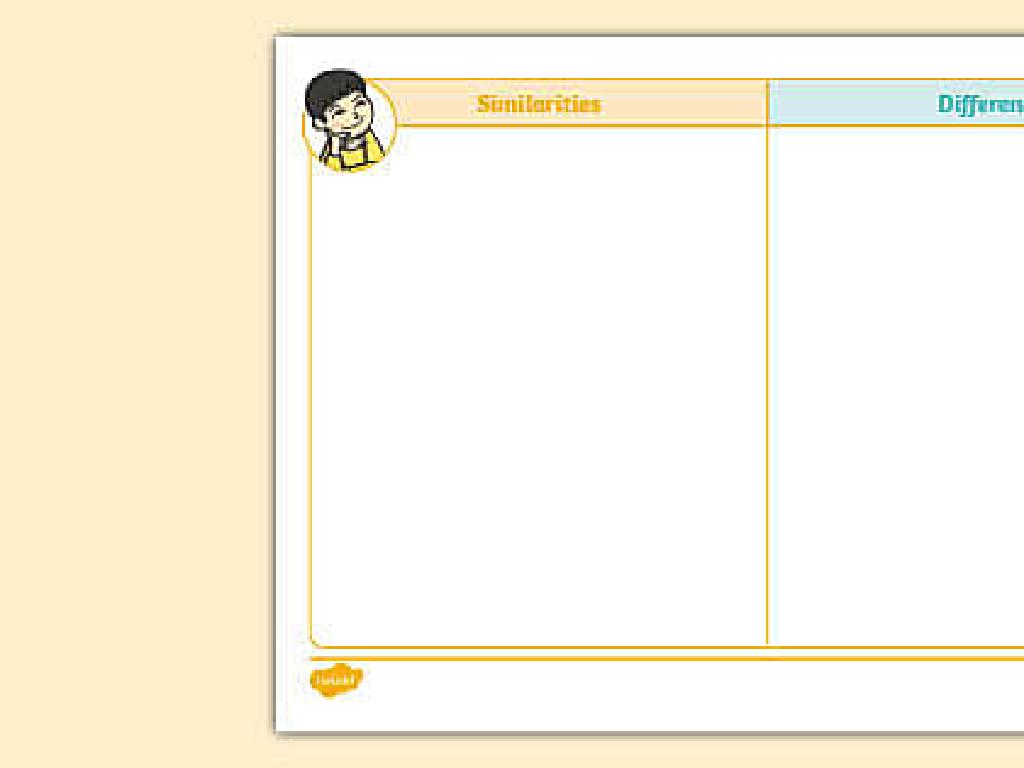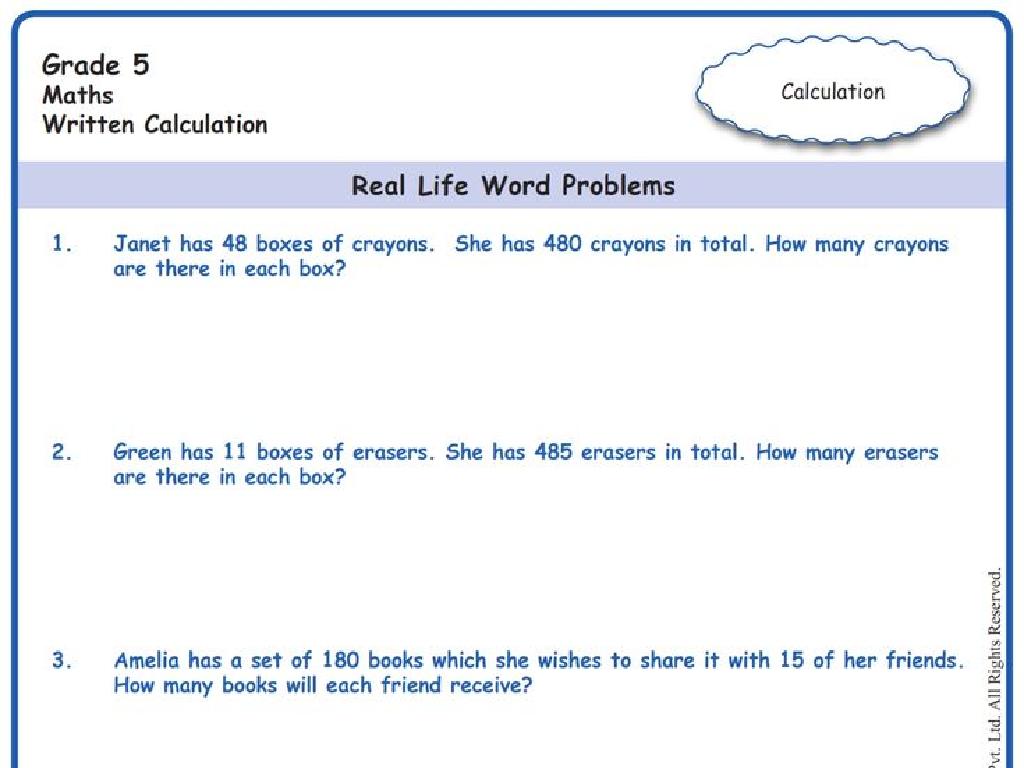Which Model Represents The Ratio?
Subject: Math
Grade: Sixth grade
Topic: Ratios And Rates
Please LOG IN to download the presentation. Access is available to registered users only.
View More Content
Welcome to Ratios!
– Understanding ratios: the basics
– A ratio shows the relative sizes of two or more values.
– Ratios in daily life
– Ratios are everywhere: recipes, maps, and even in the store!
– Exploring ratio models
– Models can be pictures, objects, or numbers that show ratios.
– Today’s focus: model representation
|
Begin the lesson by explaining the concept of ratios, emphasizing that they are a way to compare quantities. Illustrate with simple examples, such as comparing the number of apples to oranges in a fruit basket. Highlight how ratios are present in everyday situations, like following a recipe or determining distance on a map. Introduce different models that can represent ratios, such as fraction bars, ratio tables, or graphs. For today’s lesson, focus on identifying which visual or numerical model accurately represents a given ratio, ensuring students understand how to interpret and create their own models. Encourage students to think critically about how ratios are depicted and to recognize the importance of accurate representation in various contexts.
Understanding Ratios
– Define a ratio
– A ratio shows the relative sizes of two or more values.
– Ratio terms and notation
– Terms like ‘to’, ‘per’, and notation like 1:2 or 1/2.
– Real-life ratio examples
– Recipes in cooking, map scales, or mixing paints.
– Practice with ratios
|
This slide introduces the concept of ratios, a fundamental aspect of mathematics that compares quantities. Start by defining a ratio as a way to show the relationship between two numbers, indicating how many times one value contains another. Explain the language used in ratios, such as ‘to’ and ‘per’, and introduce notation like 1:2 or 1/2. Provide relatable examples such as using ratios in recipes for cooking, understanding map scales, or mixing colors in art. Encourage students to think of other areas where ratios are used and to practice creating their own ratios from everyday situations. This will help them grasp the concept and see the practical application of ratios in their daily lives.
Exploring Types of Ratios
– Understanding Part-to-Part Ratios
– Compares different categories within a set, e.g., red to blue marbles.
– Exploring Part-to-Whole Ratios
– Compares one part to the entire set, e.g., yellow marbles to all marbles.
– Grasping Equivalent Ratios
– Ratios that express the same relationship, e.g., 1:2 is equivalent to 2:4.
– Applying Ratios in Models
– Use models to visualize ratios, like pie charts or bar models.
|
This slide introduces students to the concept of ratios, focusing on understanding and identifying part-to-part and part-to-whole ratios, as well as recognizing equivalent ratios. Begin by explaining that a ratio is a comparison between two or more quantities. Use tangible examples like colored marbles to illustrate part-to-part ratios, and compare one color to the total number of marbles for part-to-whole ratios. Show how ratios can be scaled up or down to find equivalent ratios. Encourage students to think of ratios as a way to show proportions and to use models such as pie charts or bar graphs to represent them visually. This will help students to better understand and apply ratios in various contexts.
Visualizing Ratios with Models
– Visual aids for understanding ratios
– Models help us see the relationship between numbers in a ratio
– Fraction bars, tables, and graphs
– Fraction bars show parts of a whole, tables compare quantities, graphs plot ratios on a scale
– Selecting the appropriate model
– Consider the ratio and context to pick the best visual representation
– Practice with different ratios
|
This slide introduces students to various models used to represent ratios, emphasizing the importance of visual aids in understanding mathematical concepts. Fraction bars can be used to represent parts of a whole, making it easier to see the proportions. Ratio tables are useful for comparing two related quantities and observing patterns. Graphs can plot ratios on a scale, showing the relationship between the quantities visually. Encourage students to think about the nature of the ratio and the context in which it is used to determine the most effective model to represent it. Provide examples of different ratios and ask students to choose and justify the most suitable model for each. This will help them grasp the concept of ratios more concretely and apply it to real-world situations.
Ratio Models in Action
– Create a 3:2 ratio model
– Use objects like blocks to represent a ratio of 3 to 2
– Different models, same ratio
– A 3:2 ratio could be 6:4 or 9:6, all models show the same relationship
– Activity: Build a ratio model
– Choose items to represent a ratio and explain your model to the class
|
This slide introduces students to the concept of creating and interpreting models that represent ratios. Start by explaining a 3:2 ratio and how it can be represented using various objects, such as blocks or drawings. Emphasize that different models can represent the same ratio by scaling up or down, but the relationship between the quantities remains consistent. For the activity, students will create their own models using classroom materials to represent a given ratio. Provide guidance on how to select appropriate items and encourage creativity. After building, students should be prepared to explain how their model represents the assigned ratio. Possible activities include using colored beads, drawing pictures, or using fruits to represent ratios. This hands-on experience will help solidify their understanding of ratios in a tangible way.
Class Activity: Ratio Scavenger Hunt
– Find real-life ratios in class
– Create models for ratios found
– Use objects or drawings to represent ratios
– Present your ratio models
– Discuss ratio relevance
– How do these ratios help in understanding real-world problems?
|
This interactive class activity is designed to help students apply their knowledge of ratios to the world around them. Students will search the classroom for examples of ratios, such as the number of windows to doors, or the number of students with glasses to those without. They will then create physical or drawn models representing these ratios. Afterward, students will present their findings to the class, explaining the ratios they found and the models they created. The teacher should prepare by ensuring there are enough ratio examples in the classroom and by providing materials for model creation. Possible activities include comparing the number of books on different shelves, the ratio of colored markers to pens, or the number of tiles to ceiling lights. This activity will enhance students’ understanding of ratios and their ability to identify and apply them in everyday situations.
Conclusion: Understanding Ratio Models
– Recap of ratio models
– Choosing the correct model
Selecting the right model is crucial for accurate representation and problem-solving.
– Homework: Model 3 ratios
Find everyday examples and create ratio models.
– Share your models in class
Be prepared to present your models and explain your reasoning.
|
This slide wraps up our lesson on ratio models by summarizing the key points and emphasizing the importance of selecting the correct model for representing ratios. For homework, students are tasked with finding three ratios in their home environment and creating models to represent them. This could involve items like the ratio of forks to spoons in their silverware drawer or the ratio of windows to doors in their house. Encourage creativity and practical application of today’s lesson. In the next class, students will have the opportunity to share their models and discuss the reasoning behind their choices, reinforcing their understanding of ratios and how they are represented in various contexts.






